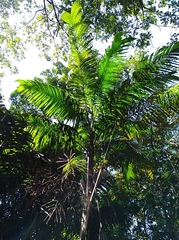

|
|
|
|
Family: Arecaceae
Súrtuba
|
Descripción: Palma de 3 a 6 m de alto. Tronco solitario. Hojas pinnadas de 1-3 m de largo, con 20-30 pares de folíolos. Pecíolo de 0.5-1 m de largo, plano en la superficie superior y con una vaina ligular en la base. Inflorescencias ramificadas, a veces de color marrón o rojizo. Flores blancas. Frutos elipsoidales o globosos, de 0.4-0.7 cm de largo, verdes, tornándose morados o negros al madurar. Datos Ecológicos: La especie crece a bajas y medianas elevaciones, en bosques húmedos o muy húmedos. En Panamá se encuentra en las provincias de Bocas del Toro, Chiriquí, Coclé, Colón, Darién, Panamá y la comarca de Guna Yala. Común en pendientes y hondonadas cercanas a los riachuelos. Florece y fructifica de mayo a septiembre. Especies Parecidas: A menudo se confunde con LK bactma Bactris major LK2 , pero B. major es una palma que crece en colonias de 2 ó más tallos y el tronco tiene espinas. También se puede confundir con LK cha1te Chamaedorea tepejilote LK2 , pero en C. tepejilote el tronco es verde y tiene raíces fúlcreas en la base. Además las hojas de C. tepejilote tienen una línea amarilla que recorre la parte inferior del raquis y el pecíolo. Usos: No se conocen usos para la especie. G. oxycarpa Mart.; G. binervia Oerst. Small, monoecious tree, to 6 m tall; trunk to 6.5 cm diam; leaf scars prominent, to 8 cm apart. Leaves glabrous, irregularly pinnate, ca 2.5 m long; petioles 40-65 cm long, vaginate at base, flattened above with sharp edges; blades often more than 2 m long; leaflets in 20-30 pairs, abruptly long-acuminate, held in a single plane, 45-60 cm long, 1-9 cm wide (except terminal), spaced 1-10 cm apart, with 1-7 ribs prominent on upper and lower surfaces; rachis flat below, becoming triangulate by middle of blade; juvenile leaves entire. Spadix somewhat maroon, compound, branched many times, 60-75 cm long, often about as broad as long, lightly pubescent; flower pits spirally arranged in 5 series ca 3-6 mm apart; staminate flowers whitish, exserted, ca 4 mm long; pistillate flowers shorter, embedded. Fruits globular-ellipsoid, 4-6 mm long; pericarp slightly fleshy, becoming reddish and finally purple to black at maturity; seed 1. Croat 7432, 9303. Occasional and usually widely dispersed in the forest. Flowering data is inconclusive. Flowers and fruits may be seen in most months of the year, but the flowers appear principally in the dry and early rainy seasons, with the fruits maturing during the rainy season. Possibly confused with Synechanthus warscewiczianus, a plant of similar habit with irregular leaves but with an inflorescence of many slender undivided branches. Some plants possibly are entirely staminate, since the inflorescences wither after flowering. I am using here the broader interpretation of this species used in the Flora of Surinam (Wessels-Boer, 1965) and not the narrower interpretation used in the monograph of geonomoid palms (WesselsBoer,1968). |






















































































